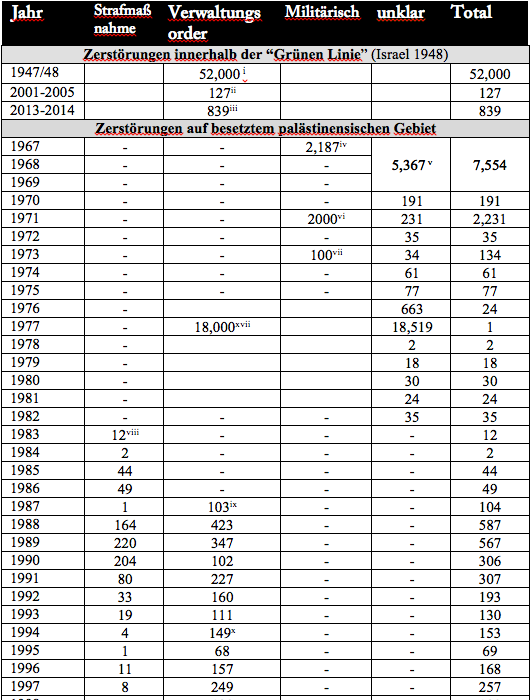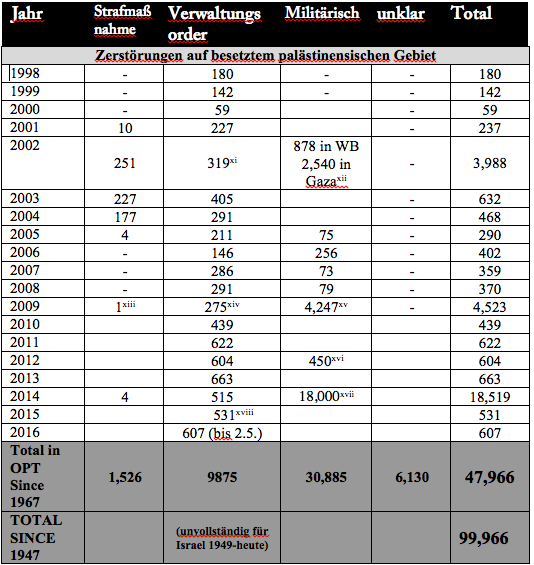STATISTIK ÜBER HAUSZERSTÖRUNGEN IN DEN BESETZTEN GEBIETEN (1947/48 -2016)
ICAHD schätzt, dass seit 1967 ca. 48 000 Häuser und Bauten (Ställe, Schuppen, Zisternen etc.) in den von Israel besetzten Gebieten zerstört worden sind. Die Quellen sind: Informationen des israelischen Innenministeriums, die Stadtgemeinde Jerusalem, die Zivile Verwaltung (= Militärbehörden in den besetzten Gebieten), OCHA (Office for the Coordination of Humanitarian Affairs, UN) und andere UN-Quellen, palästinensische und israelische Menschenrechtsorganisationen, Amnesty International, Human Rights Watch, ICAHDs eigene Untersuchungen vor Ort und andere Quellen (auf dem Stand von April 2015)
Typen von Hauszerstörungen
1. Zerstörungen als Strafmaßnahme: Hauszerstörungen als Strafe für (vermeintliche) Gewalttäter, die mit den Häusern in Zusammenhang gebracht werden. Diese Praxis wurde von der Armee im Februar 2005 aufgegeben, nachdem sich herausgestellt hatte, dass diese Maßnahme nicht abschreckt, sondern die Leute noch wütender macht und zu mehr Anschlägen führt. Diese Praxis wurde jedoch 2009 wieder aufgenommen. Obwohl die meisten Leute glauben, dieses sei der Hauptgrund, warum Häuser zerstört werden, machen sie doch nur 4% aller Hauszerstörungen aus.
2. Administrative Zerstörungen: Häuser, die wegen fehlender Baugenehmigung zerstört werden. Dies passiert in der C-Zone und in Ost-Jerusalem unter ausschließlicher israelischer Herrschaft, obwohl es auch in anderen Gebieten vorkam, als es noch keine A- B- und C-Zonen gab. Es ist wichtig, herauszustellen, dass Palästinenser keine andere Wahl haben als „illegal“ zu bauen, denn sie bekommen ja keine Baugenehmigung. Es kann auch in der B-Zone geschehen, wenn ein Haus zu nahe an einem Militärstützpunkt liegt oder nahe an einer Straße, die Soldaten oder Siedler nutzen, dass das Haus dann per Verwaltungsanordnung den Abrissbefehl bekommt. Diese Zerstörungen machen ungefähr 20% aus.
3. Operationen zur Landbereinigung/militärische Zerstörungen: Häuser, die von der IDF (israelische Armee) im Verlauf von Militäroperationen zerstört werden, zur ‚Flurbereinigung‘, um ein gewünschtes militärisches Ziel zu erreichen, oder um gesuchte Personen zu töten – Teil von Israels Politik der extralegalen Hinrichtungen. Militärische Hauszerstörungen machen 61% aus.
4. Undefinierte Zerstörungen: ICAHD sammelt Informationen über und untersucht viele Hauszerstörungen, die zwischen 1967 und 1982 durchgeführt wurden. Vorläufige Ergebnisse weisen darauf hin, dass hier Zerstörungen aller Kategorien vorkommen, aber die meisten militärische und bestrafende Hauszerstörungen sind.
Statistik der Hauszerstörungen


Für die C-Zone existieren aktuell 13 000 Abrissanordnungen, für Ost-Jerusalem 20 000. Es gibt auch Hauszerstörungen in Israel selbst, z.B. von Beduinendörfern im Negev (Um al-Hiran und Atir) oder in der „nicht anerkannten“ Gemeinde Dahmasch (zwischen Lod und Ramle), in der 2015 8 Häuser zerstört wurden und 13 weitere vom Abriss bedroht sind. Dort leben mitten in Israel viele palästinensische Familien ohne Zugang zur infrastrukturellen Grundversorgung (Straßen, Schulen, Abwasser, etc. z.T. Strom und Wasser).
i Beginning already in 1947 and extending throughout the 1948 war and into the next decade, Israel systematically demolished some 52,000 Palestinian homes, 531 entire urban neighborhoods and rural towns and villages. This was done not in the heat of battle but after the fighting had ended (in many cases years later), as a deliberate policy of displacement, of preventing any return of refugees and of taking the land. Sources: Walid Khalidi (ed), All That Remains: The Palestinian Villages Occupied and Depopulated by Israel in 1948. Washington DC: Institute for Palestine Studies, 1992; Ilan Pappe, The Ethnic Cleansing of Palestine. Oxford: One World Publications, 2006.
ii The number of homes demolished in 1948 Israel until today, not connected to the Naqba – virtually all of them Palestine/Bedouin – is still unknown and needs research. The few figures we can glean are presented here, but they are obviously fragmentary at best. The figure here is for demolitions in the Bedouin communities of the Negev. Orli Almi, The Ramifications of House Demolitions in Israel on the Mental Health of Children, 2005. Unrecognized Negev Villages Project.
iii Demolitions in the Bedouin communities of the Negev. The Negev Coexistence Forum, The House Demolition Policy in the Negev-Naqab, 2014. Retrieved at: <http://www.dukium.org/wp-content/uploads/2014/12/HDR_2014_Egnlish_web.pdf>.
iv The Israel League for Human and Civil Rights (1970), “The United Nations Commission on the Israeli Practices in the Occupied Territories,” Retrieved at: <http://domino.un.org>; United Nations General Assembly (1967) “Report of the Secretary-General Under General Assembly Resolution 2252 and Security Council Resolution 237 (1967),” Retrieved at: <http://www.domino.un.org>; Thomas Abowd (2000), “The Moroccan Quarter: A History of the Present,” Jerusalem: Jerusalem Quarterly, Retrieved at: <http://www.jerusalemquarterly.org>; Palestine Remembered (n.d.), “’Imwas,” “Bayt Nuba,” “Yalu,” Retrieved at: <http://www.palestineremembered.com>. The UN Report refers to 850 houses demolished in Qalqilya and 360 in Beit Awa. It also states that the Beit Mersim (Beit Marsam) was entirely demolished and had an original population of approximately 500. We averaged just over 8 people per house to arrive at the figure of 60 houses for this village. Also quoted in the report is the demolition of 18 houses in Surif. Abowd’s articles states that 135 houses were demolished in the Moroccan Quarter of Jerusalem’s Old City but a UN Report from 1980 raises that number to 160. We have used the lower number. The villages of Imwas, Yalu and Beit Nuba were entirely demolished in 1967. The website “Palestine Remembered” cites the 1931 British census listing 224 houses in Imwas, 245 in Yalu and 226 in Beit Nuba. According to the 1961 Jordanian census, the populations of the towns increased by 91, 70 and 43%. An extremely conservative estimate would be a 10% increase in the amount of housing by the 1961 census, adding a total of 69 more houses for a three-village-total of 764. This total does not include the numbers from the Jordan Valley villages of Nuseirat, Jiftlik, and Arajish, all of which were leveled, as those numbers are currently unavailable.
vUnited Nations General Assembly (1984), “Report of the Secretary-General, Living Conditions of the Palestinian People in the Occupied Palestinian Territories,” Retrieved at: <http://www.domino.un.org>. This is the source for all statistics on undefined demolitions between 1967 and 1982. In the actual report these are listed as punitive demolitions though a UN source states all demolitions were classified as “Collective Punishment.”
vi Human Rights Watch (2004), Razing Rafah. New York: Human Rights Watch, Retrieved at: <http://www.hrw.org/reports/2004/rafah1004/rafah1004images.pdf>; Jeff Halper (2005). Obstacles to Peace (2005) Jerusalem: PalMap. This number is from a mass demolition that took place in the Gaza Strip. It happens that Ariel Sharon was the leader of that mission.
vii UNISPAL (30 March 1979), Special Unit on Palestinian Rights, Bulletin no. 3. Retrieved at: <http://www.domino.un.org>. The 100 houses were from Beit Iksa, and were demolished for the Ramot settlement. The majority of the populace of Beit Iksa are refugees which helps to explain why there was a small distance between the village proper and the collection of houses now under Ramot. This is also mentioned in the 25 May 1984 document from the UN General Assembly, “Living Conditions of the Palestinian People in the Occupied Palestinian Territories. Report of the Secretary-General.”
viii Talmor, Ronny (1989), Demolition and Sealing of Houses as a Punitive Measure in the West Bank and Gaza Strip During the Intifada. Jerusalem: B’Tselem. This report is the source for the data on punitive demolitions from 1983-86.
ix B’Tselem (2014), “Statistics on demolition of houses as punishment 1987-2005.” Retrieved at: <http://www.btselem.org/punitive_demolitions/statistics>. All the statistics on punitive house demolitions from 1987-2005 come from this.
x B’Tselem (2006) “Statistics on Demolition of Houses Built Without Permits.” Retrieved at: <http://www.btselem.org>. All the statistics on administrative demolitions between 1987-1993 come from this.
xi Meir Margalit (2006), Discrimination in the Heart of the Holy City. Jerusalem: IPCC (Dr. Margalit is a field researcher for ICAHD).
xii Report of the Secretary-General on Recent Events in Jenin and Other Palestinian Cities. Retrieved at: <http://www.un.org/press/en/2002/SG2077.doc.htm>; Human Rights Watch (2004), Razing Rafah: Mass Home Demolitions in the Gaza Strip.; B’Tselem (2006), “Statistics on Houses Demolished for Alleged Military Purposes.” Retrieved at: <http://www.btselem.org/razing/statistics>; UN Office for the Coordination of Humanitarian Affairs (2005-2008), Weekly Humanitarian Briefings, #s 86-240.
xiii Demolition witnessed by ICAHD staff on 19 January 2009.
xiv Figures for 2009-2014 compiled by AIDA, OCHA, ICAHD and other monitoring organizations.
xv Total for houses demolished in Gaza during Operation Cast Lead, provided by UN OCHA. Retrieved at: <http://www.ochaopt.org/annual/c2/8.html>. OCHA adds that an additional 2870 homes were severely damaged. All demolitions occurring during Cast Lead are listed in 2009, despite several hundred occurring just before the new year.
xvi OCHA, The Monthly Humanitarian Report, October-Novemeber 2012. Retrieved at: <http://unispal.un.org/UNISPAL.NSF/0/6FFA3F199915CD2585257AD9006DD704>.
xvii Total for houses demolished in Gaza during Operation Protective Edge, provided by UN OCHA. Retrieved at: <http://www.ochaopt.org/documents/humanitarian_Snapshot_31_august_2014_oPt_V4.pdf>. Before Operation Protective Edge, 71,000 housing units were needed in Gaza to bring housing to an adequate level (OCHA: <http://www.ochaopt.org/annual/c2/8.html>).
xviii OCHA, Protection of Civilians. Retrieved at: < http://www.ochaopt.org/poc29december-11january-2016.aspx#4>.
